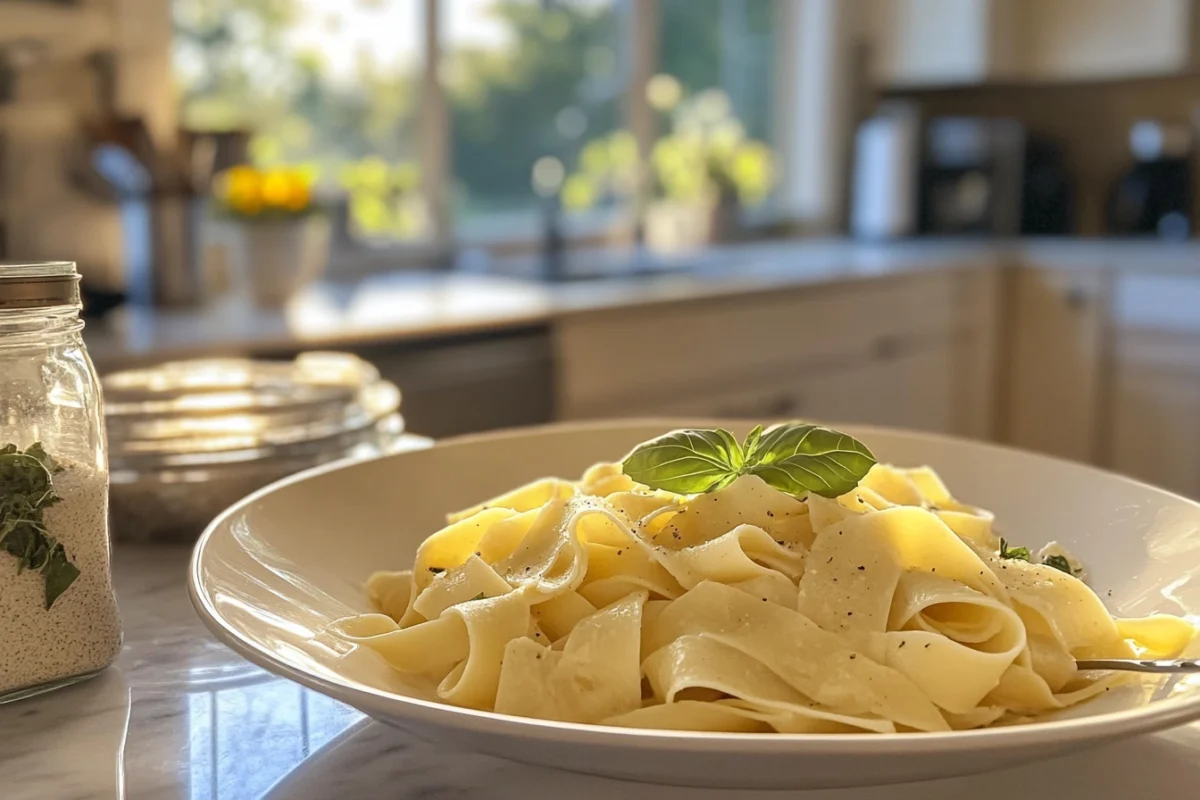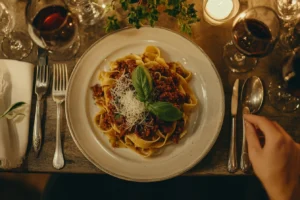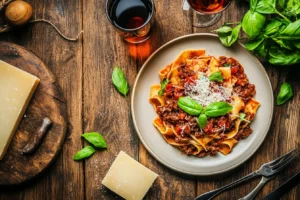What kind of pasta is pappardelle? This article explores pappardelle, a wide, ribbon-like pasta. You will learn about its origins, uses, and more. This guide helps you understand this unique pasta shape.
Understanding What Kind of Pasta is Pappardelle?
Pappardelle is a type of pasta that originates from the Tuscany region of Italy. This pasta is known for its wide, flat shape, resembling ribbons. What kind of pasta is pappardelle? It is an egg pasta, typically wider than fettuccine. Because of its width, pappardelle pasta is ideal for hearty sauces. Therefore, understanding its features is key to its culinary use.
The Origins and History of Pappardelle
The roots of pappardelle stretch back to central Italy. Historically, it was a dish often enjoyed during feasts. The wide shape of this pasta allowed it to hold rich sauces. Furthermore, its rustic nature makes it a timeless favorite in Italian cooking. Consequently, its history is interwoven with Italian culinary traditions. Indeed, pappardelle has been a staple in Italian cuisine for generations. This history is key to appreciating its cultural significance.
Distinguishing Features of Pappardelle
The key feature that sets pappardelle apart is its significant width. It usually ranges from ¾ to 1 inch wide. Additionally, it has a rough texture. This allows sauces to cling well to the pasta. Indeed, pappardelle pasta is usually made with fresh eggs. As a result, it has a rich taste. It differs from dried pasta in texture and flavor. This unique texture and taste are characteristic of pappardelle. Moreover, the width can vary slightly depending on regional traditions. This contributes to the diverse varieties available.
How is Pappardelle Made?
The making of pappardelle involves simple ingredients. Flour, eggs, and salt are the basics. First, the ingredients are mixed to form a dough. Then, the dough is rolled out thinly. Afterward, it is cut into wide strips. Fresh pappardelle cooks quickly, making it a good choice for fast meals. Consequently, the preparation process impacts the final product. Additionally, the skill of the pasta maker also plays a role. This can influence the pasta’s final texture and appearance.
The Ingredients and Tools Needed
Pappardelle requires only a few essential ingredients. These usually include flour and fresh eggs. A rolling pin is needed to flatten the dough. A sharp knife or pasta cutter helps create the wide strips. These are simple tools, therefore, making the process accessible. Additionally, a pasta machine can speed up the process. Likewise, a good cutting board and some bench flour are helpful. These tools help to ensure proper consistency and even pasta shapes.
The Process of Making Pappardelle Dough
Making dough for pappardelle involves several steps. First, the flour is mixed with eggs. Next, the dough is kneaded until it is smooth. Then, the dough rests briefly. Afterward, it’s rolled out thinly. The thin sheet is cut into ribbons. Finally, the fresh pasta is ready for cooking. Consequently, each step ensures proper texture. Specifically, kneading develops the gluten and gives the pasta a good bite. Furthermore, resting allows the gluten to relax, which makes rolling the dough easier.
Cutting the Pappardelle Ribbons
The cutting process is key to achieving the desired shape of pappardelle. Use a sharp knife to cut wide strips. A pasta cutter can also help. Ensure uniform width for even cooking. Moreover, the ribbons should be thick. This allows them to hold up well with sauce. Therefore, cutting techniques influence the pasta’s texture. Accordingly, consistent cuts make the pasta more enjoyable to eat. Additionally, a ruler can ensure even width for the pasta.
Why is Pappardelle Ideal for Certain Dishes?
The unique qualities of pappardelle make it ideal for specific types of dishes. It’s broad surface area is compatible with thick, chunky sauces. These sauces often include meat, cream, or vegetables. Because of its shape, pappardelle holds more sauce. This provides a more satisfying meal experience. Consequently, its wide shape enhances certain dishes. Besides, the texture and width of pappardelle contribute to a more complex culinary experience.
Pappardelle and Hearty Meat Sauces
Pappardelle works wonderfully with rich meat sauces. For example, a slow-cooked ragu pairs well with this wide pasta. The broad surface area allows the sauce to coat the pasta perfectly. Additionally, the pasta’s texture provides a nice bite. This creates a more indulgent experience. Therefore, it complements meat-based sauces. Indeed, the pairing of pappardelle with ragu is a classic for good reason. Moreover, the slow-cooked meat sauce adheres perfectly to the wide noodles, enhancing each bite.
Creamy and Vegetable-Based Sauces with Pappardelle
Pappardelle is also great with creamy sauces. For example, a creamy mushroom sauce is a good choice. Moreover, its width can handle a variety of vegetable-based sauces. These can range from a light tomato sauce to a heavier pesto. Therefore, pappardelle is quite versatile. Specifically, the large surface area of the pasta enhances its ability to absorb the flavors of creamy or vegetable-based sauces. Also, the pasta’s texture allows the sauce to cling well.
Pappardelle and Seafood Pairings
While less common, pappardelle can pair with seafood. Light seafood sauces pair well with this pasta. For instance, a shrimp and garlic sauce will work well. The width of this pasta helps capture all the flavors. Therefore, pappardelle offers flexible use. Furthermore, the pasta’s broad surface provides ample space for light seafood sauces to coat each strand effectively. However, it is important to use lighter sauces to not overpower the delicate flavor of the seafood.
Common Pappardelle Recipes
Pappardelle is a great base for a variety of recipes. Here are some popular dishes. Each highlights the unique qualities of this pasta. Accordingly, these recipes allow you to experience its culinary use. Notably, these recipes showcase the pasta’s versatility and flavor.
Pappardelle with Ragu
Pappardelle with ragu is a classic Italian dish. Ragu is a slow-cooked meat sauce. The wide pasta absorbs the flavors of the ragu well. Specifically, the rich sauce clings to every strand. This pairing provides a hearty and satisfying meal. Therefore, this combination is very popular. Indeed, this classic dish embodies the soul of Italian comfort food. Moreover, the slow-cooking process brings depth of flavor to the sauce, which pairs exquisitely with the texture of pappardelle.
Pappardelle with Mushroom Cream Sauce
Pappardelle pairs nicely with mushroom cream sauce. The creamy sauce coats the wide pasta evenly. Furthermore, the earthiness of mushrooms and cream is perfect. This combination results in a rich and flavorful dish. Consequently, it is a popular choice in Italian homes. Specifically, the creamy sauce is well-suited for the wide, flat surface of pappardelle. Moreover, the dish has a luxurious texture and a rich flavor profile.
Simple Pappardelle with Butter and Sage
For a more simple option, try pappardelle with butter and sage. The butter coats the pasta beautifully. The sage adds a wonderful flavor. This light dish showcases the pasta’s quality. Basically, it is a simple yet satisfying meal. Therefore, it’s an excellent way to enjoy pappardelle. Specifically, this recipe highlights the simple beauty of Italian cooking. Additionally, the fresh sage adds an aromatic quality to the dish.
How to Cook Pappardelle Properly?
Cooking pappardelle properly is essential for good results. Here are some tips. This will help you achieve the best texture and taste. Indeed, the cooking time is important. Besides, proper cooking preserves the texture and flavor.
Cooking Fresh Pappardelle
Fresh pappardelle cooks much faster than dried pasta. Usually, it will cook in just 2-4 minutes. To cook, simply boil salted water. Afterward, add the fresh pasta. Wait for the pasta to float to the top. Then, drain it quickly. Because it cooks fast, it’s key to be attentive. Therefore, you need to watch it carefully. Specifically, the quick cooking time of fresh pappardelle means you must keep an eye on it closely to avoid overcooking. Additionally, using plenty of well-salted water helps to enhance the flavor of the pasta.
Cooking Dried Pappardelle
Dried pappardelle requires longer cooking times. It may need about 8 to 10 minutes. Follow the instructions on the package. Always use plenty of salted water. Stir occasionally to prevent sticking. Taste the pasta for doneness. Eventually, it should be cooked al dente. Therefore, be patient with dried pappardelle. Furthermore, using enough water allows the pasta to cook evenly and prevents clumping. Moreover, the occasional stir is crucial for preventing the pasta from sticking to the bottom of the pot.
Tips for Perfect Pappardelle
For the best results, use a large pot. Use plenty of salted water. Cook pappardelle al dente. This means “to the tooth” in Italian. Also, never overcook the pasta. Drain the pasta quickly once done. Add the sauce right away. These small tips ensure delicious pappardelle. Therefore, proper cooking technique is important. Specifically, using a large pot gives the pasta enough room to move around while cooking, and avoid clumping. Additionally, cooking al dente will ensure the pasta has a firm texture that holds up well with sauces.
Variations and Alternatives to Pappardelle
There are variations and alternatives to pappardelle. These may offer different tastes or textures. It is good to know about these options. Chiefly, this helps when you are trying different dishes. Additionally, knowing alternative shapes can open up new culinary possibilities.
Similar Pasta Shapes to Pappardelle
-
Fettuccine: A narrower version of pappardelle.
-
Tagliatelle: Another ribbon-like pasta, slightly narrower.
-
Mafalde: A long, ribbon-like pasta with ruffled edges.
Each variety has its own unique look and feel. Therefore, they each offer different culinary experiences. Specifically, fettuccine is thinner than pappardelle, which affects the mouthfeel and sauce absorption. Likewise, tagliatelle, while similar in shape, also has its own distinct texture. Furthermore, Mafalde’s frilled edges make for a more elegant dish.
Gluten-Free Pappardelle Options
Gluten-free options for pappardelle are available. These are made from rice or corn flour. They can be found in grocery stores. They are a good option for those with gluten issues. Indeed, they offer a way to enjoy this dish without limiting food options. Specifically, these gluten-free options are designed to mimic the texture and flavor of traditional pappardelle. However, they may have a slightly different cooking time.
Homemade Variations on Pappardelle
Making pappardelle at home allows for variations. You can add flavors to the dough. These may include herbs or spices. These variations offer a unique twist. Another option is to add different types of flour. You can be flexible and create new flavors. Specifically, experimenting with different herbs and spices can add a personal touch to your homemade pasta. Moreover, using alternative flours like semolina or buckwheat can alter the flavor and texture of the pasta.
Health Benefits of Pappardelle
While pappardelle is known for its taste, there are some additional health aspects to consider. Here’s a look at its nutritional value. However, these are only a few of the benefits. Additionally, understanding the nutritional value can help you incorporate the pasta into a healthy diet.
Nutritional Profile of Pappardelle
Pappardelle is a good source of carbohydrates. Carbohydrates provide energy. Also, it may contain some proteins. The nutrients will change depending on the ingredients. Always be conscious of this when choosing your pasta. Specifically, the exact nutritional content will vary depending on whether it’s fresh or dried and the recipe’s ingredients. Furthermore, the use of whole wheat or other alternative flours can alter the nutritional profile as well.
How Pappardelle Fits into a Balanced Diet
When eaten as part of a balanced diet, pappardelle can be part of a healthy meal. Pair it with vegetables and proteins. This adds more nutrients. Remember, portion size is key. Specifically, eating in moderation is vital to maintain health. Therefore, pappardelle can be part of a good diet. Besides, pairing your pappardelle with lean proteins, fresh vegetables, and healthy fats can create a more balanced and satisfying meal.
Considerations for Pappardelle Consumption
Be mindful of portion sizes when eating pappardelle. It is best to balance it with other food groups. Moreover, be mindful of the sauce. Choose sauces that are low in fat and sodium. Finally, choose high-quality ingredients. This will make your pasta healthier. Therefore, you need to consider all factors. Additionally, choosing whole wheat pappardelle when available can add more fiber to your diet. Also, choosing fresh over dried pasta can often reduce sodium intake.
Frequently Asked Questions (FAQs)
What is the difference between pappardelle and fettuccine?
The main difference is in width. Pappardelle is much wider than fettuccine. Specifically, pappardelle is usually about ¾ to 1 inch wide. Fettuccine is narrower, around ¼ inch. Additionally, this difference in width also impacts how the pasta absorbs and holds different types of sauces.
How do you pronounce pappardelle?
The correct pronunciation is “pah-par-DEL-leh.” Emphasis is on the third syllable. This is a common question for those new to the pasta. Indeed, knowing the proper pronunciation allows for clear communication in culinary settings. Moreover, confidently pronouncing the dish adds to the cultural appreciation.
What sauces go well with pappardelle?
Hearty sauces pair well with pappardelle. These include meat ragu and creamy sauces. It’s also good with vegetable sauces. This is due to the large surface area of the pasta. Specifically, the wide surface area is ideal for capturing the richness of these sauces. Also, the rough texture helps them cling effectively to the strands of pasta.
Can I make pappardelle at home?
Yes, pappardelle is easy to make at home. It requires only basic ingredients. You’ll also need a rolling pin and a knife or pasta cutter. The homemade version is always great. Additionally, making your own pappardelle offers the satisfaction of creating something from scratch. Moreover, it allows you to customize the pasta’s texture and flavors to your liking.
Conclusion
In conclusion, pappardelle is a truly remarkable pasta that stands out due to its distinctive wide, ribbon-like shape and its rich texture. What kind of pasta is pappardelle? It’s more than just a simple noodle; it’s a culinary canvas, perfect for holding hearty sauces and creating memorable meals. From its humble origins in Tuscany to its current status as a beloved dish around the world, pappardelle exemplifies the best of Italian cooking. Its versatility allows it to pair with a wide array of sauces, from classic meat ragus to creamy mushroom creations, making it a staple for any food lover. Additionally, the ability to make pappardelle at home allows for even greater creativity and personalization, enabling cooks to experiment with flavors and textures. Therefore, whether you’re a seasoned chef or a home cook, exploring the possibilities with pappardelle is both rewarding and delicious. So, the next time you’re searching for a pasta that can truly elevate your meal, remember pappardelle, and you won’t be disappointed. Undoubtedly, this pasta’s unique qualities make it a valuable and versatile addition to your culinary repertoire. Finally, its combination of rich flavor, satisfying texture, and historical depth makes pappardelle a genuinely exceptional choice.
To explore more pasta and food-related topics on RecipesCaia, check out these articles:
- Learn how pappardelle pairs with various dishes in our Pappardelle Guide.
- Explore the differences between pasta types and toppings in our Ultimate Guide to Turron.
- For inspiration on pairing appetizers with pasta meals, read about Naturally Delicious Fruit Cups.



